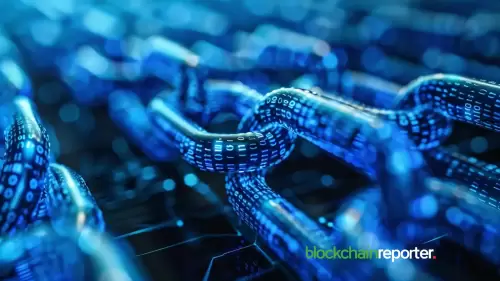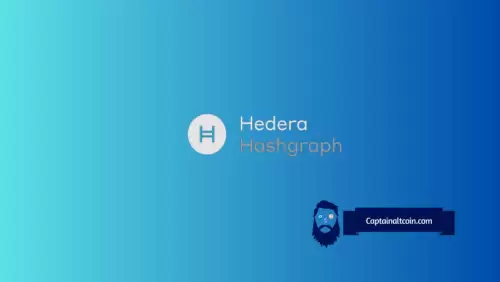 |
|
 |
|
 |
|
 |
|
 |
|
 |
|
 |
|
 |
|
 |
|
 |
|
 |
|
 |
|
 |
|
 |
|
 |
|
Cryptocurrency News Articles
Encapsulate Joins the IOTA Ecosystem as a New Validator
May 10, 2025 at 04:28 pm
This choice reflects a strong push toward decentralization and global coverage. Encapsulate already runs nodes on over 35 proof-of-stake chains.

Recently, IOTA announced that Encapsulate has joined its ecosystem as a new validator. This choice highlights a strong push toward both decentralization and global coverage.
The Importance of Geographic Diversity in IOTA Validators
This move expands on the stellar performance and reliability that Encapsulate is known for in the crypto space. The company already runs nodes on over 35 proof-of-stake chains. These nodes are maintained to the highest standards, ensuring network stability and optimal operation. This dedication to excellence is directly transferable to the IOTA ecosystem.
The Indian node expands the geographic diversity of the validator infrastructure. This diversity is crucial for minimizing latency and improving user experience across different regions. As the IOTA Network continues to grow, institutions are playing an increasingly important role in maintaining it.
Key Functions and Governance Limits in IOTA Validator
On the IOTA Network, validators perform more than just basic node duties. They also manage software updates, gas price proposals, and on-chain commands. This responsibility is reflected in the stringent protocols for joining the validator program.
To become a validator, a staking pool must accumulate at least two million IOTA and follow best practices in key management and security. A validator can be removed if it fails to keep the required stakeholders or performs poorly. This step is essential for maintaining the operational integrity of the network and preventing downtime. It also deters against misconfigured or poorly maintained nodes, ensuring optimal performance and stability.
IOTA Validator Tokenomics outlines how power and rewards stay balanced in the system. In this model, no user can stake unlimited amounts toward one validator. Instead, each validator’s voting power caps at ten percent of the total votes. Any extra tokens staked beyond this cap lose direct influence. Those extra votes get redistributed across the validator set. This design prevents any validator from becoming disproportionately powerful, even with large support pools.
The Importance of Staking Mechanics and Reward Distribution
To earn rewards, users stake tokens with IOTA validators. These deposits create StakedIOTA objects tagged by timestamp. This timestamp fixes each user’s share of the block and reward eligibility. Users can withdraw their stakes at any time using the previous epoch’s rate, ensuring fairness in distribution. A single-staked IOTA object cannot be split for partial withdrawal. However, multiple stakes can be unstaked in segments at the user’s discretion, offering flexibility for both casual and high-volume stakers. This flexibility encourages users to spread their risk and rewards evenly by staking through multiple validators.
IOTA validators also play a role in setting the gas fees across the network. Each validator proposes a gas price for the next epoch, and the network uses the two‐thirds percentile of those weights. This method contributes to keeping gas fees stable for users during regular operations.
Validators can reuse their proposals or update them as needed. For instance, if there are sudden changes in gas prices due to market shifts, validators can adjust their proposals accordingly. In this dynamic setting, Encapsulate plans to actively participate in the gas pricing process with its usual focus on performance and reliability.
How does the IOTA Slashing System Ensure Accountability?
A slashing system called the Tallying Rule ensures that validators are held accountable for their actions and performance.
Every epoch, IOTA validators score each other’s performance, noting any errors or instances of underperformance in their logs. After each epoch, these scores are tallied for potential slashing. If a validator performs poorly, it will be slashed, which can result in a reduction of the validator’s rewards for the next epoch. This system incentivizes validators to stay reliable, act honestly, and perform at a high standard.
Community dashboards track these scores and performance metrics, fostering transparency among participants. This penalty process is part of the Validator Tokenomics design to maintain optimal performance standards across the network. Users can view the results of this performance evaluation online through public performance dashboards, highlighting the open and accountable nature of the IOTA ecosystem.
Disclaimer:info@kdj.com
The information provided is not trading advice. kdj.com does not assume any responsibility for any investments made based on the information provided in this article. Cryptocurrencies are highly volatile and it is highly recommended that you invest with caution after thorough research!
If you believe that the content used on this website infringes your copyright, please contact us immediately (info@kdj.com) and we will delete it promptly.
-

-

-

-

-

- Bitcoin Breaks Through the $100000 Level, Reaching $104000
- May 10, 2025 at 11:25 pm
- Bitcoin broke through the $100000 level this week, reaching $104000 before moderating to about $103000. The move came after news that US and Chinese officials would sit down in Switzerland to talk about a possible trade agreement.
-

-

-

- BlockDAG (BDAG) CertiK Audit Fuels $233.5M Presale, Ethereum (ETH) Price Action Weakens, Tether News Pushes Security Upgrades
- May 10, 2025 at 11:20 pm
- This week's market is a mix of hesitation, preparation, and a new wave of presale excitement. Ethereum (ETH) price action continues to lose momentum, hovering just above the danger zone as bulls look for a turnaround at $1,770.
-

- As of May 9, a renewed optimism has washed over the crypto market as cryptocurrencies turned green following a prolonged bearish trend.
- May 10, 2025 at 11:15 pm
- XRP, for instance, has been on the rise, recording a 6.8% rise in the past day. Although XRP price increase follows the general market uptrend, it's also an impact of the impending SEC legal battle resolution and the engagement with Wellgistics, a global healthcare firm.
























































